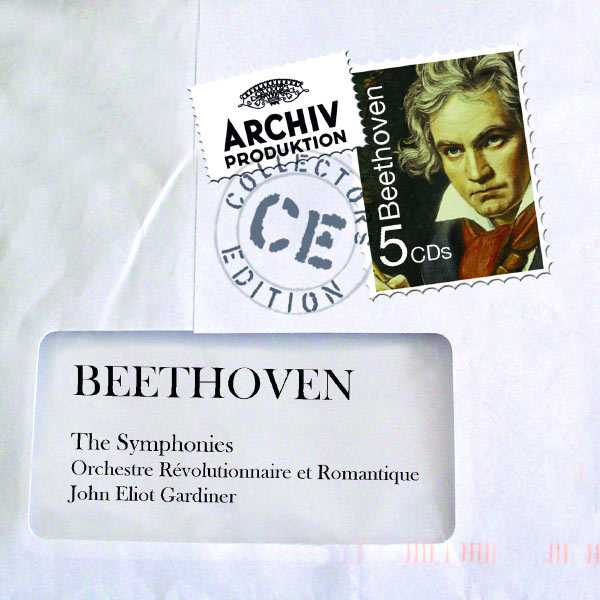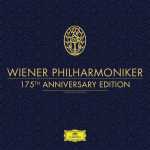
Composer: Ludwig van Beethoven
Performer: Luba Orgonasova, Anne Sofie von Otter, Anthony Rolfe Johnson, Gilles Cachemaille, Monteverdi Choir
Orchestra: Orchestre Révolutionnaire et Romantique
Conductor: John Eliot Gardiner
Number of Discs: 5
Format: FLAC (tracks)
Label: Archiv
Catalogue: 4778643
Release: 2010
Size: 1.39 GB
Recovery: +3%
Scan: yes
CD 01
Symphony No. 1 in C Major, Op. 21
01. I. Adagio molto – Allegro con brio
02. II. Andante cantabile con moto
03. III. Menuetto (Allegro molto e vivace)
04. IV. Finale (Adagio – Allegro molto e vivace)
Symphony No. 2 in D Major, Op. 36
05. I. Adagio molto – Allegro con brio
06. II. Larghetto
07. III. Scherzo (Allegro)
08. IV. Allegro molto
CD 02
Symphony No. 3 in E-Flat Major, Op. 55 “Eroica”
01. I. Allegro con brio
02. II. Marcia funebre (Adagio assai)
03. III. Scherzo (Allegro vivace)
04. IV. Finale (Allegro molto)
Symphony No. 4 in B-Flat Major, Op. 60
05. I. Adagio – Allegro vivace
06. II. Adagio
07. III. Allegro vivace
08. IV. Allegro ma non troppo
CD 03
Symphony No. 5 in C Minor, Op. 67
01. I. Allegro con brio
02. II. Andante con moto
03. III. Allegro
04. IV. Allegro
Symphony No. 6 in F Major, Op. 68 “Pastoral”
05. I. Erwachen heiterer Empfindungen bei der Ankunft auf dem Lande: Allegro ma non troppo
06. II. Szene am Bach: (Andante molto mosso)
07. III. Lustiges Zusammensein der Landleute (Allegro)
08. IV. Gewitter, Sturm (Allegro)
09. V. Hirtengesang. Frohe und dankbare Gefühle nach dem Sturm: Allegretto
CD 04
Symphony No. 7 in A Major, Op. 92
01. I. Poco sostenuto – Vivace
02. II. Allegretto
03. III. Presto – Assai meno presto
04. IV. Allegro con brio
Symphony No. 8 in F Major, Op. 93
05. I. Allegro vivace e con brio
06. II. Allegretto scherzando
07. III. Tempo di menuetto
08. IV. Allegro vivace
CD 05
Symphony No. 9 in D Minor, Op. 125 “Choral”
01. I. Allegro ma non troppo, un poco maestoso
02. II. Molto vivace
03. III. Adagio molto e cantabile
04. IV. Presto – Allegro assai
05. IV. Presto – “O Freunde nicht diese Töne”
The 1990s were a peak period for historically informed performances, and the most praised box set to emerge from this boom time was John Eliot Gardiner’s 1994 survey of Ludwig van Beethoven’s nine symphonies, brilliantly played on original instruments by the redoubtable Orchestre Révolutionnaire et Romantique. If any early music conductor or authentic practice ensemble ever succeeded in changing public opinions and transforming standard repertoire, surely top honors belong to Gardiner and his musicians, for their refreshing takes on Beethoven’s core masterpieces not only won over many converts to the cause, but permanently changed the way these works are played. The crisp sonorities, the brisk rhythms, and the volatile energy of these electric performances proved once and for all that Classical performances need not be fragile, dainty, or rarefied, but should be just as robust and invigorating as any mainstream interpretation, and even more exciting for taking a few risks. Indeed, it was Gardiner’s ear-opening set that showed how stodgy and sluggish many of the older established Beethoven cycles sounded in comparison, and after this set was released, most new recordings revealed its impact, particularly in the adoption of revised tempos, leaner textures, and cleaner sonorities. Traditionalists may still balk at Gardiner’s interpretations or find his changes unnerving (particularly the quicker tenor solo in the finale of the Ninth), but no one who claims to know the symphonies should ignore this set, for its significance in Beethoven studies cannot be overrated. Highly recommended.



